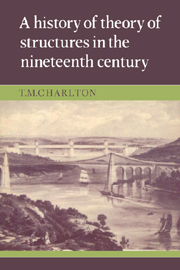Book contents
- Frontmatter
- Contents
- Preface
- 1 Introduction
- 2 Beam systems
- 3 Theory of the arch and suspension bridge
- 4 Elementary theory of frameworks: graphical statics
- 5 Theory of statically-indeterminate frameworks: the reciprocal theorem
- 6 Levy's theory of frameworks and bridge girders
- 7 Early developments of energy principles relating to theory of structures
- 8 The later development and use of energy principles
- 9 Applications of the least work principle: elastic theory of suspension bridges
- 10 Aspects of the further development of theory of structures
- 11 Secondary effects in structures
- Appendices
- I A note on C.L.M.H. Navier, based on an obituary notice by Baron de Prony
- II A note on Carl Culmann
- III A note on John Robison
- Bibliography
- Name index
- Subject index
I - A note on C.L.M.H. Navier, based on an obituary notice by Baron de Prony
Published online by Cambridge University Press: 18 September 2009
- Frontmatter
- Contents
- Preface
- 1 Introduction
- 2 Beam systems
- 3 Theory of the arch and suspension bridge
- 4 Elementary theory of frameworks: graphical statics
- 5 Theory of statically-indeterminate frameworks: the reciprocal theorem
- 6 Levy's theory of frameworks and bridge girders
- 7 Early developments of energy principles relating to theory of structures
- 8 The later development and use of energy principles
- 9 Applications of the least work principle: elastic theory of suspension bridges
- 10 Aspects of the further development of theory of structures
- 11 Secondary effects in structures
- Appendices
- I A note on C.L.M.H. Navier, based on an obituary notice by Baron de Prony
- II A note on Carl Culmann
- III A note on John Robison
- Bibliography
- Name index
- Subject index
Summary
The following is an abridged version of the author's free translation of Navier's Obituary Notice of 1837, by Prony, which is included in the 1864 edition of Navier's Leçons, edited and with additional notes by Saint-Venant.
Louis-Marie-Henri Navier, officier de la Légion d'Honneur, member of l'Institut Royale de France and Divisional Inspector of le Corps Royale des Ponts et Chaussées, was born in Dijon on 15 February 1785. His father was a lawyer of distinction and died at an early age as a result of the excesses of the revolutionaries.
Navier, orphaned at fourteen years of age, had the good fortune to find a second father in an uncle, numbered with reason among the notables of le Corps des Ponts et Chaussées, M. Gauthey, who, having been an engineer for the region of Bourgogne, became Inspector General of bridges and highways following the departmental organisation of France; he died 14 July 1807, after having designed and accomplished works of the greatest importance including the remarkable constructions mentioned later in this notice.
Navier's education, supervised by Gauthey, had (not surprisingly) that emphasis on scientific culture which would be familiar to an engineer; the progress of the young pupil was such that in 1802 he presented himself for examination for admission to l'Ecole Polytechnique and was among the highest in order of merit; after a brilliant record there, he entered l'Ecole des Ponts et Chaussées in 1804, and in 1808 obtained the qualification of ordinary engineer.[…]
- Type
- Chapter
- Information
- A History of the Theory of Structures in the Nineteenth Century , pp. 164 - 168Publisher: Cambridge University PressPrint publication year: 1982

